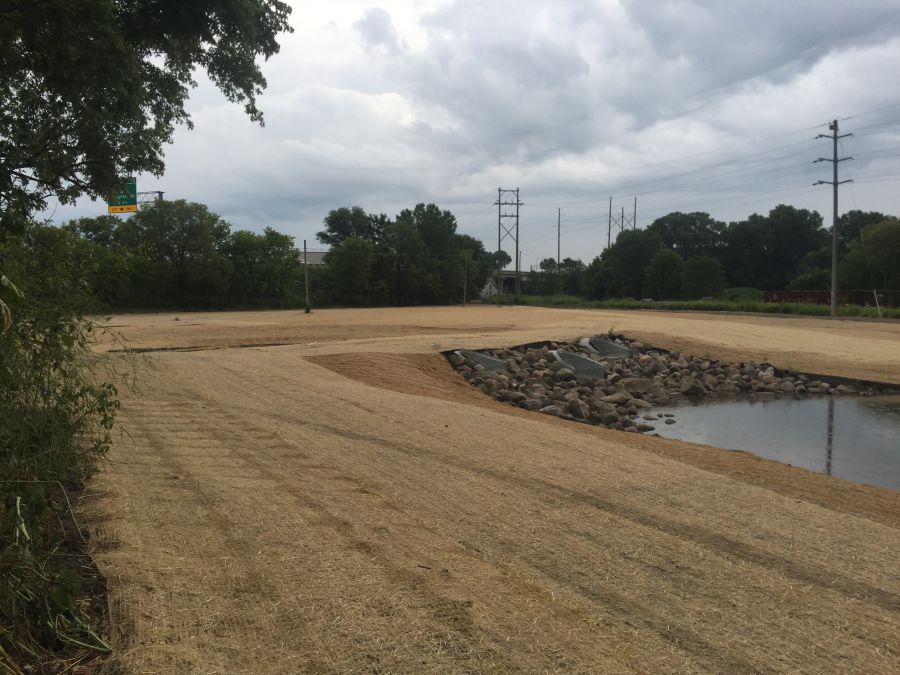Reconstruction
As stormwater storage needs change or ponds and greenways erode, fill in or become overgrown, they may require reconstruction to ensure continued functionality. The City is conducting Watershed Studies that define where additional conveyance or storage capacity it needed to achieve flood mitigation goals, and engineers perform routine inspections of ponds and greenways to see if they are rapidly eroding.

Reconstructions are important to improve water quality, and make the storm sewer system more flood resilient.
When the City reconstructs a pond or greenway, the neighboring residents will be informed as part of the public information process. Often times, existing trees need to be removed in order to stabilize banks, modify the storage or flow capacity and create a maintenance access road. Installing maintenance access roads is standard and necessary procedure to ensure City staff and equipment can access the pond or greenway to perform preventative maintenance and make repairs.
Design Process
- Once a project is programmed and budgeted, detailed design-level data is collected, including topographic survey, tree inventories and wetland delineations (where applicable)
- Computer models are updated to reflect current conditions and a conceptual design is developed to meet the goals of the project
- Public meetings are hosted to gather feedback on the conceptual designs, and understand community needs
- The design is refined and shared with the public
- The project is approved for bidding by the necessary Boards and Commissions—typically the Board of Public Works and Common Council
- The project is bid, awarded and constructed by a contractor
- The vegetation restoration work is usually completed by an ecological restoration contractor after construction is finished.
Design Elements
- The project’s primary goals can include: Flood storage, flood capacity, water quality benefits, or any combination thereof
- Designs include future maintenance access of the site, and any maintenance access needed for existing infrastructure
- Trees are kept wherever possible if they are healthy, desirable native species that support native wildlife and are well-suited for stormwater management
- Trees that are typically removed include invasive/aggressive/problematic tree species that outcompete native plant species, harm wildlife, spread disease, create hazards for people or property, exacerbate erosion or conveyance issues or otherwise compromise the ecological health of a site
- Safety features are part of standard designs. An example of this is designing a “safety bench” around stormwater ponds with standing water. A safety bench is a gently sloped area that is created so there are is not a sudden drop off at the water’s edge. These benches are typically 15 ft wide and installed at a 10:1 slope to encourage wetland vegetation to grow. The tall, dense, wetland vegetation creates a barrier to prevent people and pets from swimming and playing in the stormwater ponds, which is not advised.
- Fencing is not installed around stormwater infrastructure. Fences make emergency access more challenging in an event that a rescue would need to occur. They are also more difficult to work around for maintenance such as mowing.
Modifications to Vegetation and Screening
If you live adjacent to, or across from stormwater land, you may desire to keep the existing vegetation because it provides screening from neighbors or a street, or because you enjoy using it in the current state.
The City manages public land based on the policies, procedures, missions and values of the City. As such, stormwater land may be reconstructed for a public purpose. When this occurs the views and uses from adjacent properties may change.
If the reconstruction project is for a pond or greenway, Engineering will typically restore these areas with species native to the areas historic savannas, prairies and wetlands. If the change of screening is a concern, private property owners are encouraged to plant vegetation on their property to address screening concerns.
Additional Resources
Learn more about the overall reconstruction process in our Streets and Paths section of the Engineering Division website.
Please visit our Ecological Restoration in Stormwater Ponds and Greenways StoryMap for a brief overview in the history, objectives, management strategies and renewed approach to improve ecological biodiversity through our pond and greenway reconstruction process.
